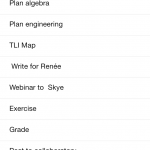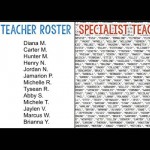Core Proposition 3: Teachers are responsible for managing and monitoring student learning.
I know what you’re thinking: that’s what the tests do!
Yes, this is mandated and micromanaged if you teach a tested subject.
I want to challenge you to step away from the test and look at the other ways you manage and monitor student learning.
Core Proposition 3 breaks into five sub-categories:
- Teachers call on multiple methods to meet their instructional goals
- Teachers support student learning in varied settings and groups
- Teachers value student engagement
- Teachers regularly assess student progress
- Teachers engage students in the learning process
In this posting, I’m going to discuss the first two sub-categories. I’ll expand on the following three in a future post.
Teachers call on multiple methods to meet their instructional goals.
In the directions for component 1, constructed responses, exercise 2 asks for six learning activities to teach a single concept. Experienced teachers develop engaging and fun methods for dull concepts. Students must experience joy in learning for there to be any retention. Last week I was leading an intervention lesson on sight words. I guided students through reading the list, using flashcards with a partner, and playing the game “Swat” with the words projected on the whiteboard. The first two activities were to get them warmed up and fresh the sight words in their memory. The game was to invoke joy. The students were divided into teams and competed to see which team could use a fly swatter to hit the word on the board first. There was laughing, excitement, and jumping around during this activity. Multiple methods lead to deeper retention.
As a candidate support provider for National Board candidates, I have noticed the confusion between the state standard and the instructional goal. As teachers, we must take that standard and personalize it to our students and our teaching.
Let’s look at a third grade standard for general music:
Grade 3 MU.CR.1.3
- Improvise rhythmic and melodic ideas (e.g., beat, meter, and rhythm).
- Generate musical ideas (e.g., rhythms and melodies) within specified tonality and meter.
I would restate this to say: The instructional goal of this unit is to improvise rhythms using 1/4 1/8 notes and 1/4 rests and melodies using the notes sol-mi-la while playing xylophones and basic rhythm instruments.
My students are familiar with rhythms and notes. I can state clearly why this is an appropriate goal for these students at this time. I can also discuss how I will build on this knowledge in the next unit.
As teachers, we must break down that broad standard to state a specific goal for our students. Learning becomes specific to your students’ learning.
Teachers support student learning in varied settings and groups
No one I know uses a single setting for teaching every concept.
There is the “sage on the stage” where the teachers impart knowledge to students. Don’t throw it out just because it’s not in the latest cutting-edge conversations in educational circles. It is a valid format and appropriate at times.
I often have students work with partners or in small groups. This arrangement gives students an opportunity to work independently the freedom to move ahead, students who need a little support from a peer that opportunity, and students who need one-to-one instruction with me the opportunity for that without missing part of another activity.
For instance, some of my students learn to play the recorder (a small and inexpensive baroque era instrument). I have seen a lot of success with presenting a melody in a whole group then having students practice with a partner to work out squeaks and fingerings. This setting is also an excellent opportunity for me to coach students individually.
What are ways to pull your learning goals out of your standards?
What are the benefits of using multiple settings and groups?
I’ll be posting about the other three sub-categories in February. I hope you find the discussion of the National Board Core Propositions beneficial.









